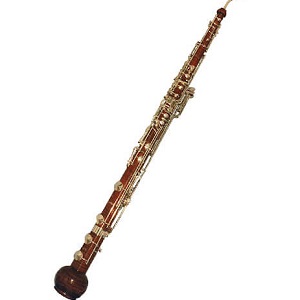Heckelphone Clarinet
 The heckelphone-clarinet is a woodwind instrument with a beak-shaped mouthpiece and single-reed, which was first built by Wilhelm Hermann Heckel in 1907.
The heckelphone-clarinet is a woodwind instrument with a beak-shaped mouthpiece and single-reed, which was first built by Wilhelm Hermann Heckel in 1907.
It was developed to amplify the woodwind instruments of the baritone in the marching music at the time. The heckelphone-clarinet was to take over the third clarinet, which originally used an alto clarinet. However, since the tone of the narrow cylindrical drilled clarinet was insufficiently viable and unsupportive for marching music, the heckelphone-clarinet was initially changed to a non-typical conical bore. Its name comes from the fact that it was also the third clarinet in marching music.
The instrument is made entirely from wood and has a wide conical bore, so it can also be called a wooden saxophone. In addition, it also has a spherical bell, called love foot, as found in the heckelphone. The fingering of the instrument corresponds to the oboe, the English horn and the heckelphone.
The heckelphone-clarinet is in B and has the modulation capability and suppleness of the saxophone, without, however, possessing the resulting twang from a metal body. In addition, the sound is not as short and brassy as that of the saxophone, but is round and far-reaching. In addition, the tone colour, especially the depth, resembles the heckelphone combined with the strong and noble sound of the clarinet.